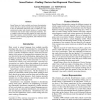292 search results - page 6 / 59 » Discriminative K-means for Clustering |
RIAO
2007
13 years 9 months ago
2007
The purpose of text clustering in information retrieval is to discover groups of semantically related documents. Accurate and comprehensible cluster descriptions (labels) let the ...
WWW
2008
ACM
14 years 8 months ago
2008
ACM
Disambiguating person names in a set of documents (such as a set of web pages returned in response to a person name) is a key task for the presentation of results and the automatic...
IHI
2010
13 years 2 months ago
2010
Unsupervised word sense discrimination relies on the idea that words that occur in similar contexts will have similar meanings. These techniques cluster multiple contexts in which...
AAAI
2004
13 years 9 months ago
2004
SenseClusters is a freely available word sense discrimination system that takes a purely unsupervised clustering approach. It uses no knowledge other than what is available in a r...
ICML
2007
IEEE
14 years 8 months ago
2007
IEEE
We combine linear discriminant analysis (LDA) and K-means clustering into a coherent framework to adaptively select the most discriminative subspace. We use K-means clustering to ...

